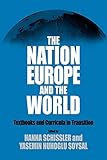The Nation, Europe, and the World : Textbooks and Curricula in Transition / ed. by Yasemin Nuhoglu Soysal, Hanna Schissler.
Material type: TextPublisher: New York ; Oxford : Berghahn Books, [2005]Copyright date: ©2005Description: 1 online resource (268 p.)Content type:
TextPublisher: New York ; Oxford : Berghahn Books, [2005]Copyright date: ©2005Description: 1 online resource (268 p.)Content type: - 9781571815507
- 9781782381747
- 907/.1 23
- online - DeGruyter
| Item type | Current library | Call number | URL | Status | Notes | Barcode | |
|---|---|---|---|---|---|---|---|
 eBook
eBook
|
Biblioteca "Angelicum" Pont. Univ. S.Tommaso d'Aquino Nuvola online | online - DeGruyter (Browse shelf(Opens below)) | Online access | Not for loan (Accesso limitato) | Accesso per gli utenti autorizzati / Access for authorized users | (dgr)9781782381747 |
Frontmatter -- Contents -- List of Figures and Tables -- Preface -- Introduction: Teaching beyond the National Narrative -- Part I: Europe Contested -- 1. Projections of Identity in French and German History and Civics Textbooks -- 2. Privileged Migrants in Germany, France, and the Netherlands: Return Migrants, Repatriates, and Expellees after 1945 -- 3. What Counts as History and How Much Does History Count? The Case of French Secondary Education -- 4. The Decline and Rise of the Nation in German History Education -- Part II: Europe Seen from the Periphery -- 5. Nation and the Other in Greek and Turkish History Textbooks -- 6. “Europe” in Bulgarian Conceptions of Nationhood -- 7. Learning about Europe and the World: Schools, Teachers, and Textbooks in Russia after 1991 -- 8. Europe in Spanish Textbooks: a Vague Image in the Space of Memory -- Part III: Global Frameworks and Approaches to World History -- 9. World History and General Education: How to Bring the World into the Classroom -- 10. Cartographies of Connection: Ocean Maps as Metaphors for Inter-Area History -- 11. World History: Making Sense of the Present -- Notes on Contributors -- Index
restricted access online access with authorization star
http://purl.org/coar/access_right/c_16ec
Textbooks in history, geography and the social sciences provide important insights into the ways in which nation-states project themselves. Based on case studies of France, Germany, the Netherlands, Spain, Greece, Turkey Bulgaria, Russia, and the United States, this volume shows the role that concepts of space and time play in the narration of ‘our country’ and the wider world in which it is located. It explores ways in which in western European countries the nation is reinterpreted through European lenses to replace national approaches in the writing of history. On the other hand, in an effort to overcome Eurocentric views,’world history’ has gained prominence in the United States. Yet again, East European countries, coming recently out of a transnational political union, have their own issues with the concept of nation to contend with. These recent developments in the field of textbooks and curricula open up new and fascinating perspectives on the changing patterns of the re-positioning process of nation-states in West as well as Eastern Europe and the United States in an age of growing importance of transnational organizations and globalization.
Mode of access: Internet via World Wide Web.
In English.
Description based on online resource; title from PDF title page (publisher's Web site, viewed 25. Jun 2024)


